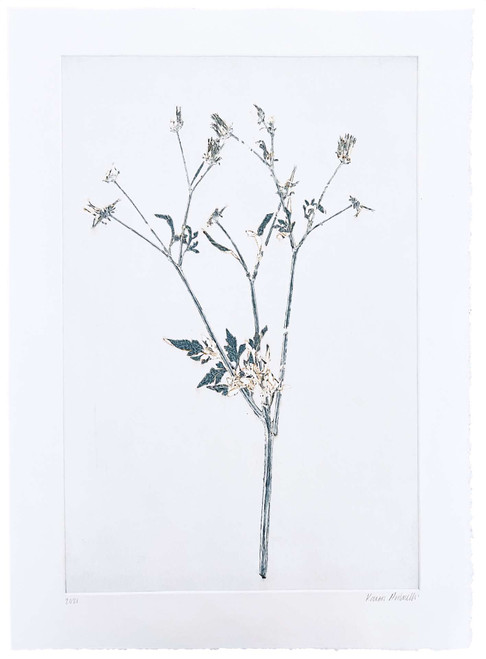Karen Antonelli
Unknown Weed 2021.18.3.1
Black Blue Oil-Based Ink on 100% Acid Free Paper
21" X 14" (unframed art on paper)
2021
Antonelli's nature ink reliefs were created from plants that grow along the railway line behind her studio in Larimer. With this series, she is reflecting on the ability of growing things to fulfill their purpose despite the challenges that weather, insects, and human actions throw at them.
To create her nature prints, Antonelli arranges the plant material on an inked zinc plate, lays a piece of dampened paper over it, and runs it through the printing press. This creates a silhouette where the specimen blocks the ink on the plate from coming in contact with the paper. The result is a negative image, with the texture of the stems, leaves, seed heads, etc. embossed into the paper.
After the first impression is taken, Antonelli peels off the plant and puts it on a clean plate with the side that picked up ink the first time through the printing press facing up. Another piece of dampened paper goes on top and she runs it through the press again. This time, Antonelli gets a well-defined positive image, where the ink on the plant prints onto the paper. If the plant fiber is fibrous and robust enough, it can be printed until there is no ink left and the paper is simply indented by the plant: this is called "blind embossing".
Antonelli can make a third image print from the original plate that has ink residue from the first pressing with the shape and textures of the plant pressed into it. If there is enough ink left on this plate, she can make a "ghost" print. An unpredictable process, the number of times the material can go through the press is limited. Softer, fleshier plants are only good for the first silhouette image and fall apart when peeled off the plate. Sometimes the plant will contribute its own color to the print, where a particularly fleshy part exudes sap under the pressure of the press.







